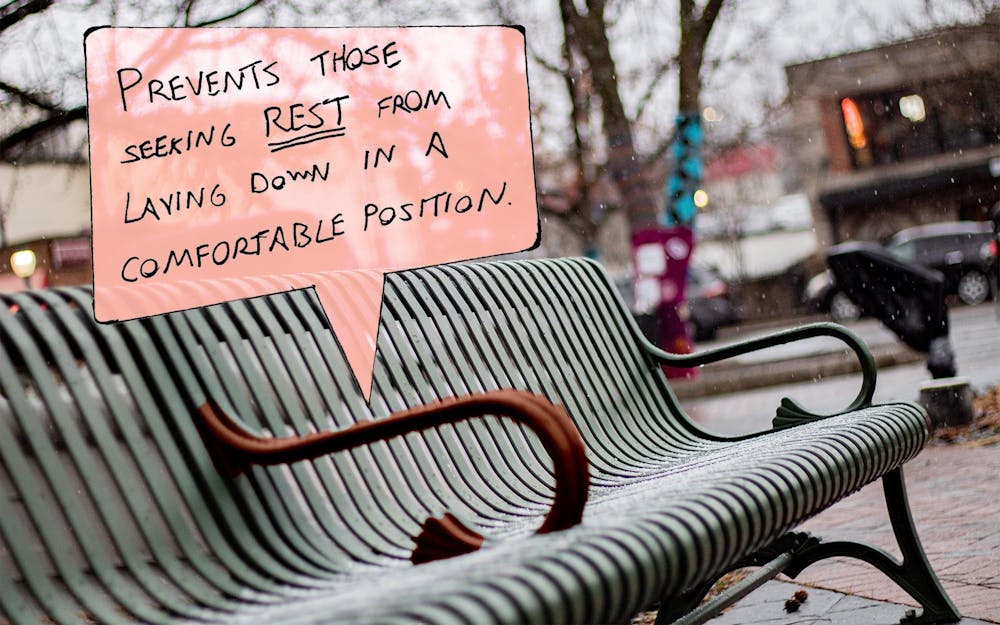During a harsh, Indiana winter, the Bloomington Police Department destroyed multiple encampments inhabited by individuals experiencing homelessness under the direction of Mayor John Hamilton. The Bloomington community voiced their concerns in a city council meeting Jan. 14, but the police continued to remove shelters and other large objects from Seminary Park — an act of pure hate that proves devastating to a vulnerable community.
It is evident that individuals experiencing homelessness aren’t welcome in Seminary Park, but other places in Bloomington signal they aren’t welcome there either. The city’s anti-homeless architecture is a passive and constant reminder of Bloomington’s callousness toward our neighbors and community members.
[Related: Nearly 100 people join meeting to express anger before sweep of Seminary Park]
Anti-homeless architecture, also known as hostile architecture, appears in cities as a purposeful design to prevent homeless individuals from populating an area. Common designs include slanted or curved benches to deter people experiencing homelessness from comfortably resting. Close bench partitions, segmented seats and even spiked window sills are also examples.
Although seemingly blatant in larger cities, anti-homeless architecture is still prevalent in smaller cities like Bloomington. You can see it in our parks and on our streets if you keep an eye out.
Hostile architecture can easily be misconstrued as sleek design and a new way to envision park seating. The reality of their purpose is far more insidious, though.
People’s Park, for example, is ridden with anti-homeless architecture, such as single-seat pedestals and divided benches. Walking along the B-Line Trail at Switchyard Park, you could find benches with partitions in the middle, preventing individuals experiencing homelessness from comfortably lying down.
These examples are a direct attack on the Bloomington homeless population, sending an unwelcoming signal. Single-seat pedestals are virtually impossible to sleep on, while the partitions on the benches are not wide enough to fit an average-sized person.
Under the mayor’s direction, these hostile forms of architecture appear everywhere in Bloomington.
“These are really tough times to be poor, out on the street, not having a place to isolate and I want to thank the community which has worked so hard to make that possible,” Hamilton said in a press release to Bloomington’s homeless population on December 15, 2020.
Although the mayor claims to care about people experiencing homelessness in his city, various sights around Bloomington refute this claim. Through the city’s hostile architecture, it is evident that homeless individuals are not welcomed in Bloomington.
Homeless shelters seem to provide an effective solution to homelessness, but some homeless individuals prefer the alternative: sleeping outside.
David Pirtle, a former homeless man in Seattle with schizophrenia, highlighted this feeling in 2012 when he told NPR, “Part of the reason was, you know, the paranoia and the fear of large groups of people that comes along with schizophrenia, but part of the reason was, and I think this is more generally the case with people, is that you hear a lot of terrible things about shelters.”
Homeless shelters are not an inclusive solution. Some homeless shelters, such as Wheeler Mission, also have strict policies regarding sobriety, but according to the National Coalition for the Homeless, approximately 38% of the homeless population in the United States are physically dependent on alcohol. A zero-tolerance policy for alcohol or other substances is a grave misunderstanding on how to treat addiction in the homeless population, which prevents many from entering a shelter.
During the COVID-19 pandemic, Bloomington needs secure, safe, places for homeless individuals to rest outside of a homeless shelter. Shelters must comply with COVID-19 restrictions, often limiting the number of beds available. The consequences of the COVID-19 pandemic, such as lack of space and fears of gathering indoors, are an obstacle to entering a shelter.
Tyler, a man experiencing homelessness in Bloomington, spoke of this during public comment in a city council meeting Jan. 14.
“People were coughing. People not wearing their masks, not social distancing. I didn’t feel comfortable breathing,” he said about his stay at Wheeler.
There must be another option.
Providing comfortable, safe places for people to rest is always essential, but it has reached a new urgency through the pandemic.
Bloomington’s anti-homeless architecture cannot be misconstrued to mean anything other than an infringement on human life. All instances of its use must be replaced.
Russ (he/him) is a sophomore studying mathematics, international law and Chinese. He is a member of IUSG on the Diversity, Equity, and Inclusion committee and a curator for TEDxIU. He aspires to work in gender and sexuality law.






